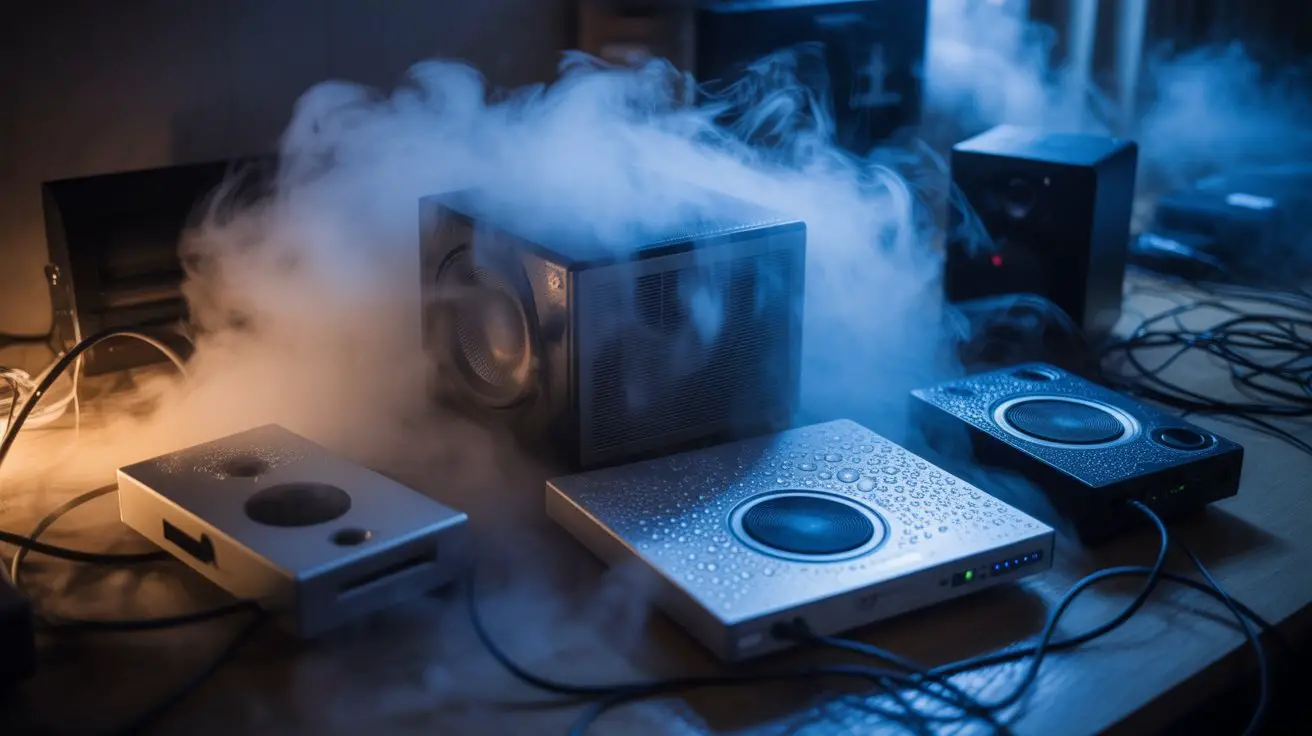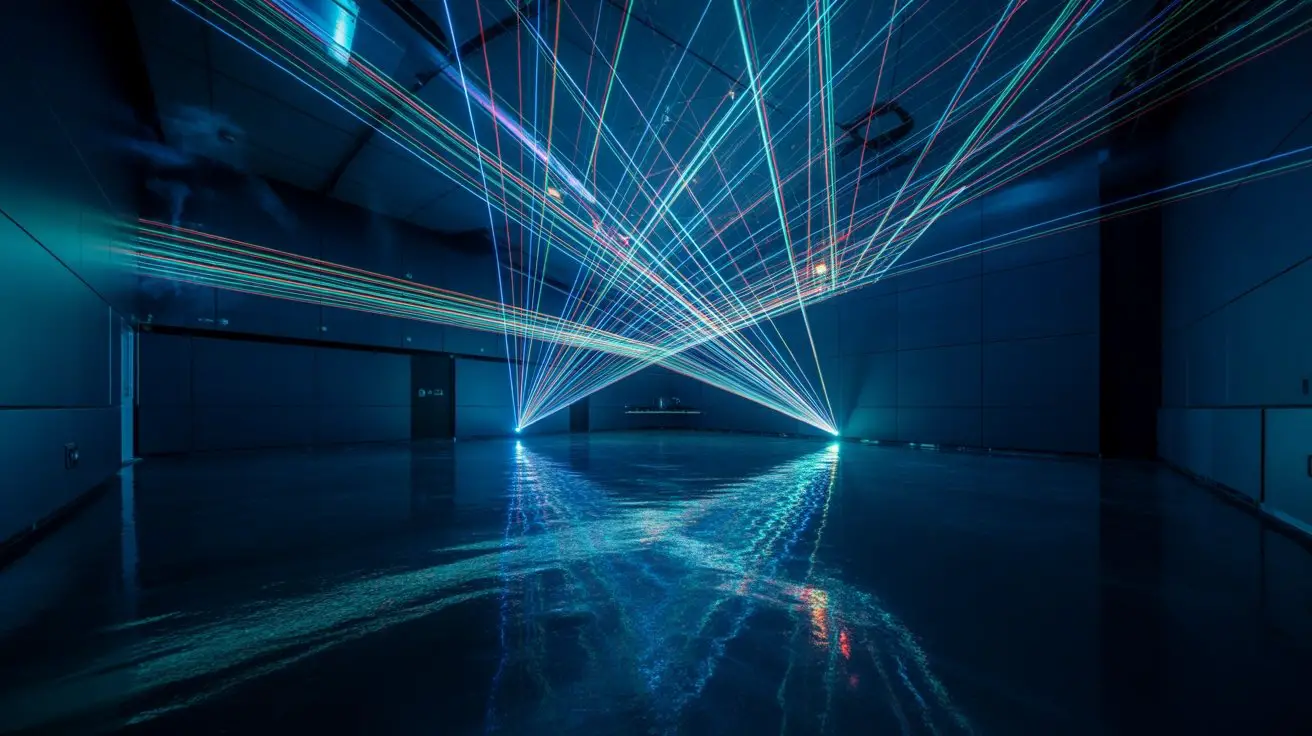While fog machines create stunning atmospheric effects, they can simultaneously release electronic equipment’s worst nightmare. You’re dealing with glycol-based particles that increase ambient humidity by 15-30% and leave microscopic residues on circuit boards. These moisture levels exceed most consumer electronics’ operating specifications of 40-60% relative humidity. Your sensitive equipment faces corrosion risks within hours of exposure, yet the full extent of damage depends on factors most event planners never consider.
How Fog Machines Work and What They Produce
When you activate a fog machine, it heats a specialized fluid—typically a glycol or glycerin-based solution—to temperatures between 400-500°F, causing rapid vaporization that creates dense water droplets suspended in air.
This process generates fog particles measuring 0.2-0.5 microns in diameter, creating the visible effect you see. The heated fluid transforms from liquid to vapor instantaneously, then condenses when it contacts cooler ambient air.
You’ll notice the fog contains approximately 85-95% water vapor, with the remaining percentage consisting of glycol or glycerin residue. These microscopic particles remain airborne for 10-30 minutes depending on ventilation conditions.
The fog’s composition directly impacts its interaction with surfaces. While primarily water-based, the glycol content creates a slightly oily residue that settles on nearby objects as particles gradually descend. Additionally, prolonged exposure to fog machine mist can lead to serious conditions like bronchitis or emphysema.
Types of Fog Fluids and Their Chemical Composition
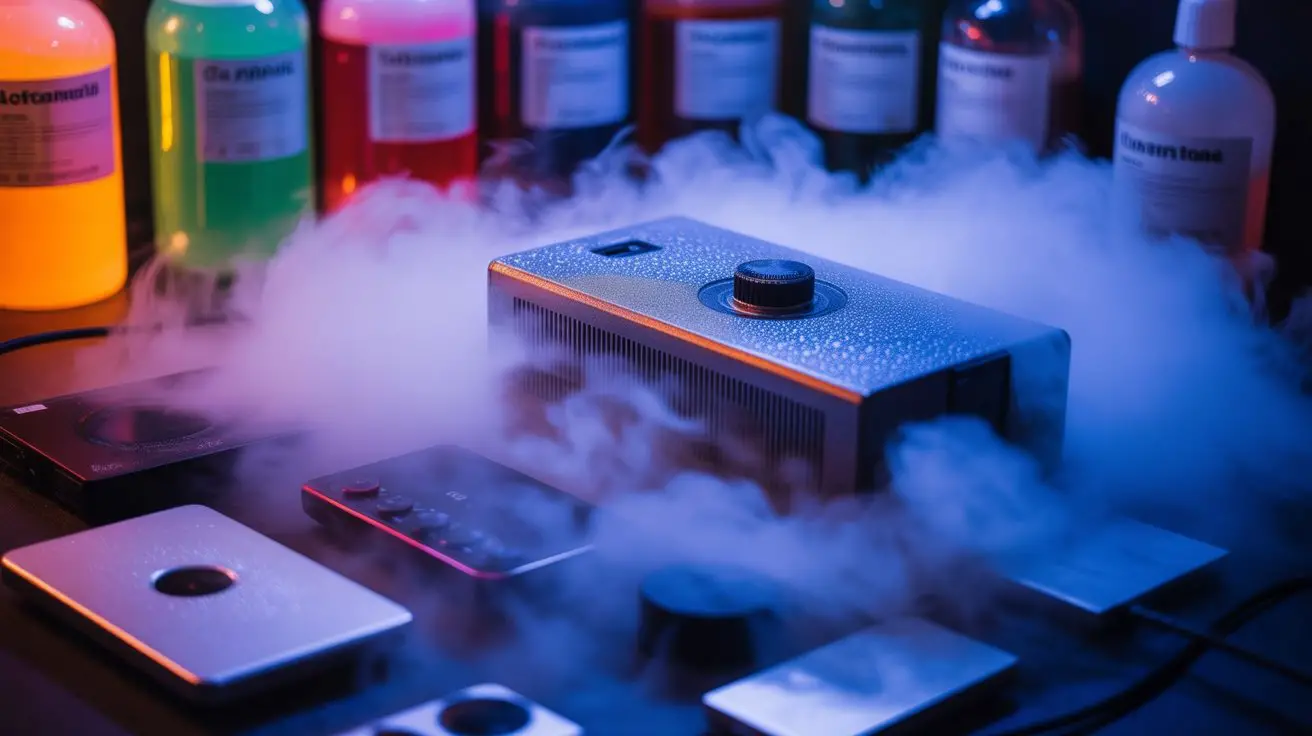
Three primary categories of fog fluids dominate the market, each featuring distinct chemical compositions that affect both fog quality and potential electronic damage.
Water-based fluids contain propylene glycol or glycerin mixed with distilled water, creating minimal residue but offering shorter-lasting effects.
Oil-based formulations utilize mineral oils that produce denser, longer-lasting fog but leave oily deposits on surfaces.
Glycol-based solutions combine ethylene or propylene glycol with water additives.
Key chemical components include:
- Propylene glycol – Low toxicity, minimal electronic impact
- Glycerin – Natural humectant, attracts moisture
- Mineral oil – Creates residue, potential conductivity issues
- Ethylene glycol – Higher toxicity, corrosive properties
- Distilled water – Carrier medium, affects particle density
You’ll find that glycol-based fluids pose the greatest risk to electronics due to their hygroscopic nature and potential for creating conductive pathways. Additionally, proper ventilation is essential for all fog types, as inhalation of fog components can pose health risks.
Potential Risks to Electronic Equipment
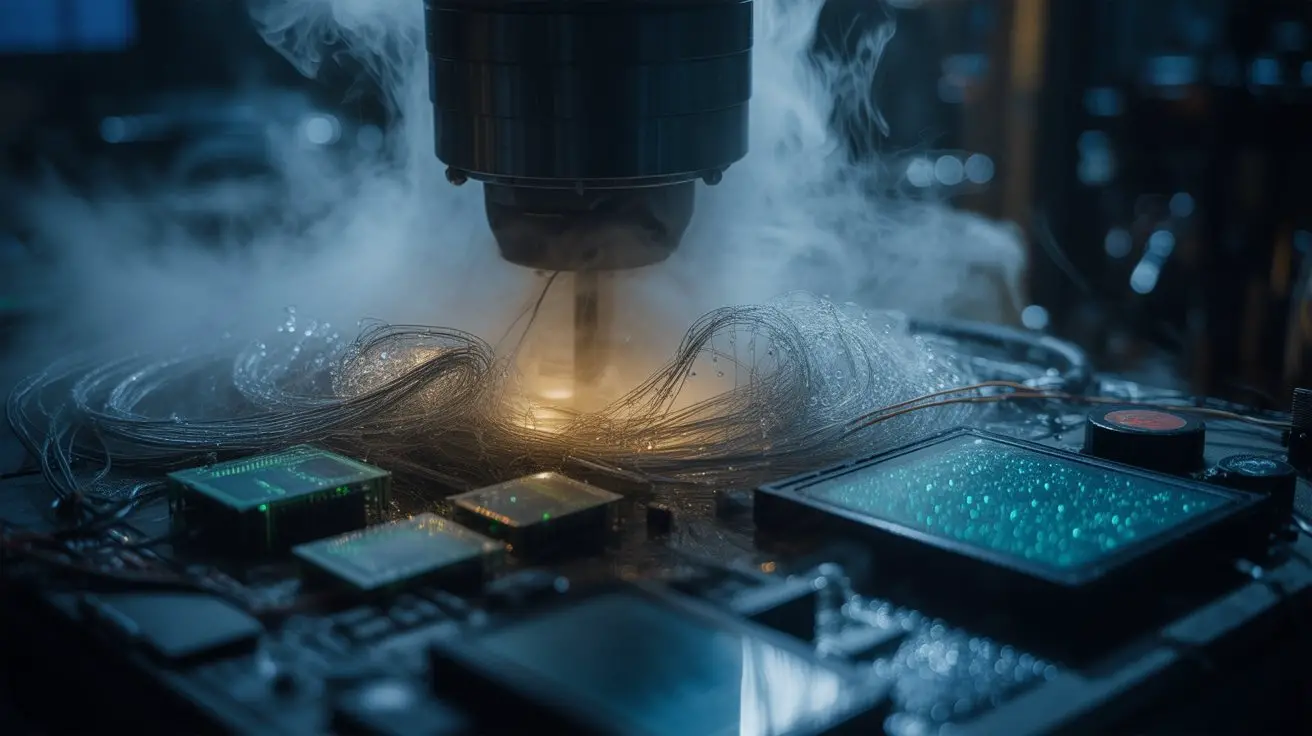
Electronic components face several distinct hazards when exposed to fog machine emissions, with moisture infiltration representing the most immediate threat to circuit integrity.
When fog particles settle on circuit boards, they create conductive pathways that cause short circuits, voltage drops, and component failure. You’ll find glycol-based fluids particularly problematic since they leave residue that attracts additional moisture and dust, creating persistent contamination layers.
Corrosion accelerates when fog deposits interact with metal contacts and traces. The combination of moisture and chemical compounds initiates oxidation processes that degrade conductivity over time.
Temperature fluctuations compound these issues—as fog evaporates, thermal cycling stresses solder joints and component connections.
Ventilation systems can’t always prevent accumulation in sensitive areas, making even brief exposure potentially damaging to precision electronics.
Moisture and Humidity Effects on Electronics
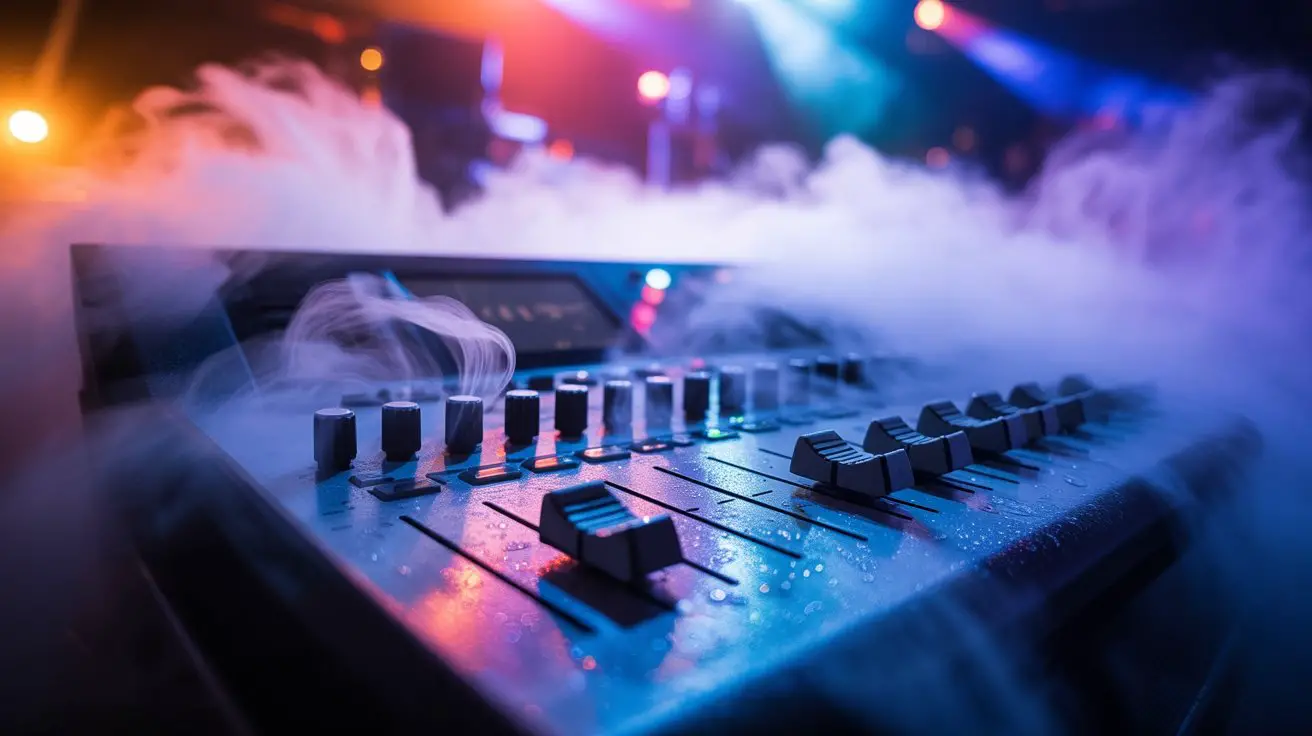
Although electronics manufacturers specify ideal humidity ranges between 45-55% relative humidity, fog machines routinely push ambient moisture levels to 80-95% within seconds of activation.
You’re fundamentally creating a saturated environment that exceeds safe operating parameters for most electronic devices.
Excessive moisture causes predictable failure patterns:
- Corrosion acceleration – Metal contacts oxidize rapidly in high-humidity conditions
- Insulation breakdown – Moisture reduces dielectric strength of circuit board materials
- Short circuit formation – Water droplets create unintended electrical pathways
- Capacitor degradation – Hygroscopic materials absorb moisture, altering electrical properties
- Thermal cycling stress – Condensation and evaporation cycles expand/contract components
When you operate fog machines near electronics, you’re forcing components to function outside their engineered tolerance ranges, dramatically reducing reliability and operational lifespan. Additionally, prolonged exposure to fog can exacerbate respiratory issues, which may affect operators working in close proximity to fog machines.
Residue Buildup and Long-Term Damage
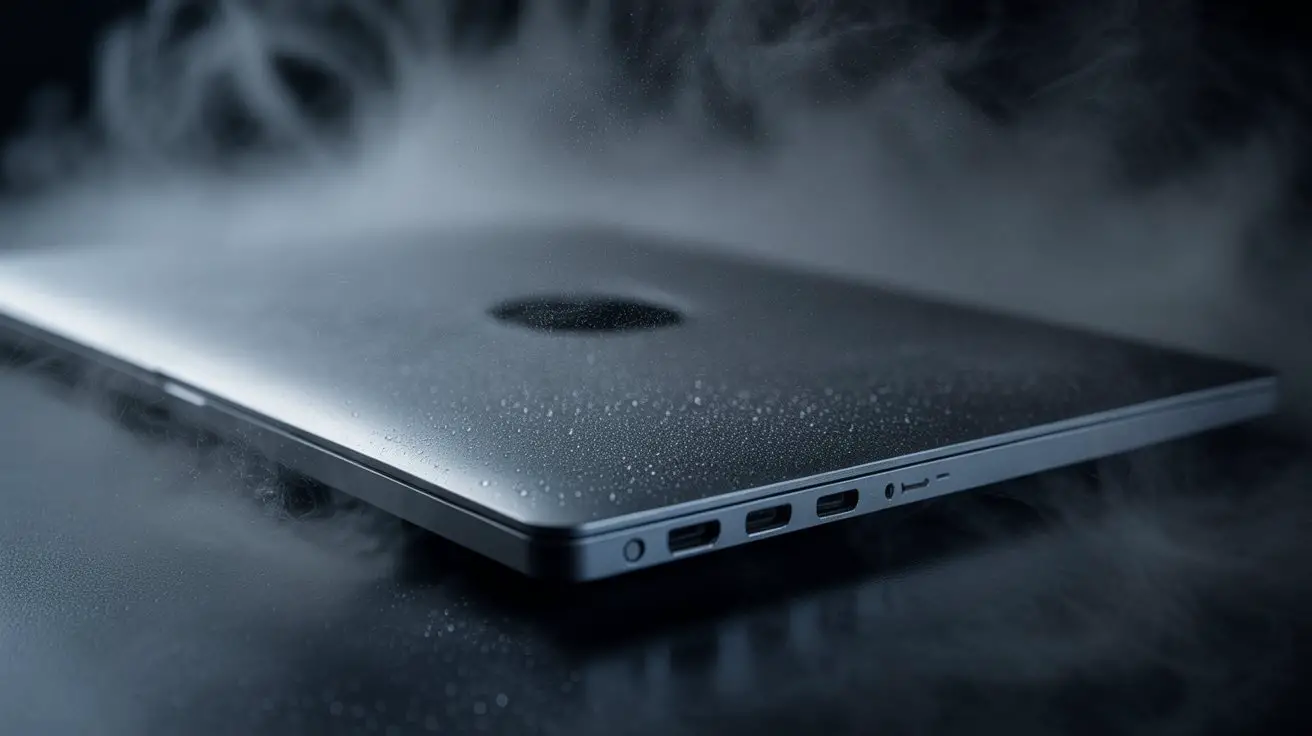
While moisture creates immediate risks, fog fluid residue accumulates over time to cause progressive degradation you won’t notice until significant damage occurs.
Glycol-based fog fluids leave microscopic deposits on circuit boards, connectors, and heat sinks. These residues attract dust particles, creating insulating layers that reduce thermal dissipation by 15-30%.
You’ll experience gradual performance throttling as components overheat under normal loads.
Residue buildup increases electrical resistance across contact points, causing voltage drops and signal degradation. Memory modules and expansion slots show particular vulnerability, with connection failures occurring after 200-300 hours of exposure.
Cleaning becomes progressively difficult as residues polymerize under heat cycling. Professional-grade electronics require residue-free environments to maintain manufacturer warranties and operational specifications. Additionally, using water-based fog fluids can help minimize the risk of residue buildup on sensitive electronic components.
Most Vulnerable Types of Electronic Devices
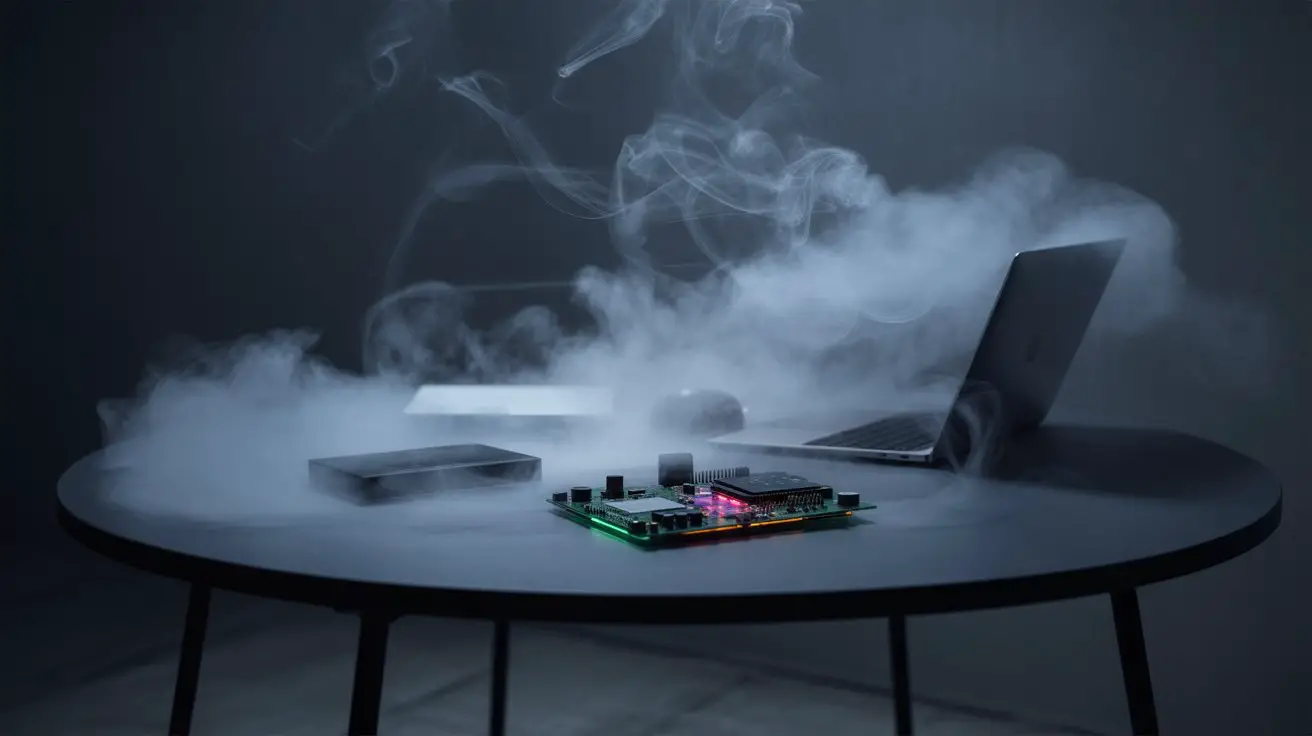
Gaming consoles and high-performance computers face the greatest risk from fog exposure due to their complex cooling systems and tight component spacing.
These devices actively draw air through their internal components, accelerating fog particle infiltration and moisture accumulation.
Your most vulnerable electronics include:
- Gaming consoles – Internal fans pull fog particles directly onto circuit boards and heat sinks
- Desktop computers – Multiple intake fans create strong airflow paths for fog penetration
- Audio mixing boards – Exposed sliders and potentiometers trap glycol residue, causing operational failures
- Projectors and lighting controllers – Optical components fog over while circuit boards accumulate conductive residue
- HVAC systems – Air handlers distribute fog particles throughout ventilation networks, contaminating downstream equipment
You’ll notice these devices struggle first because they can’t effectively seal against airborne contaminants while maintaining necessary cooling airflow. Additionally, fog machines can pose a risk of false alarms in venues, which may lead to increased humidity levels that further impact electronic devices.
Safe Distance Guidelines for Equipment Placement
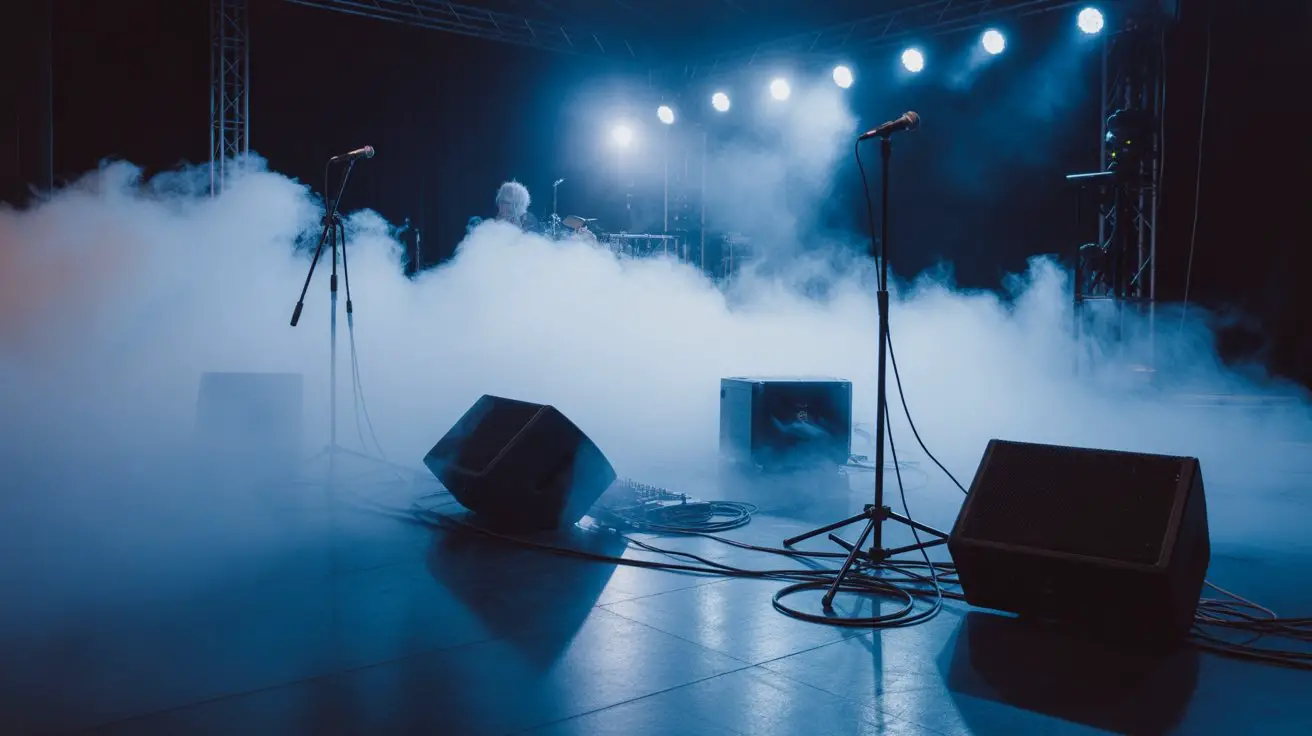
Since fog density decreases exponentially with distance from the source, you’ll achieve perfect protection by maintaining minimum 15-foot separation between fog machines and critical electronics.
Professional venues typically establish 20-25 foot buffer zones for high-value equipment like mixing consoles, amplifiers, and servers.
Position fog machines below electronic equipment when possible—fog particles naturally rise and disperse upward.
Install physical barriers or baffles between fog outputs and sensitive devices to redirect particle flow.
Monitor humidity levels at equipment locations; readings shouldn’t exceed 60% relative humidity.
Create designated “fog-free zones” using directional fans or HVAC systems to maintain positive air pressure around critical electronics.
Map fog dispersal patterns during initial testing to identify best placement coordinates before permanent installation.
Protective Measures and Best Practices
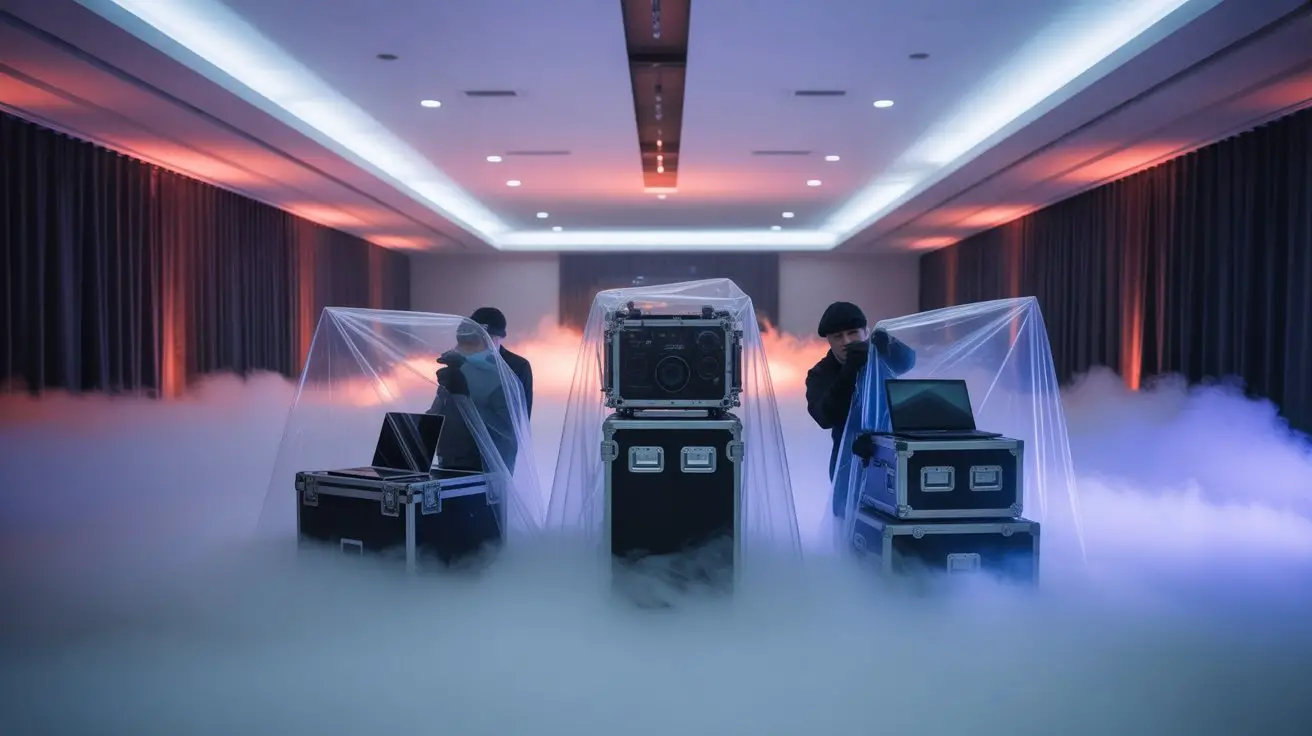
Beyond spatial considerations, implement multiple layers of protection to safeguard your electronics from fog-related damage.
You’ll need systematic approaches that address both immediate exposure risks and long-term moisture accumulation.
Deploy these protective measures:
- Waterproof enclosures – House sensitive equipment in IP65-rated cases with sealed gaskets
- Directional ventilation – Install exhaust fans to redirect fog particles away from electronics
- Desiccant packets – Place moisture-absorbing materials inside equipment housings
- Barrier shields – Position transparent acrylic panels between fog sources and devices
- Power isolation – Install surge protectors with moisture detection that automatically disconnect power
Monitor humidity levels continuously using digital hygrometers.
Maintain equipment temperatures above dew point to prevent condensation formation.
Schedule regular cleaning cycles to remove residue buildup that attracts moisture retention.
Professional-Grade Vs Consumer Fog Machines
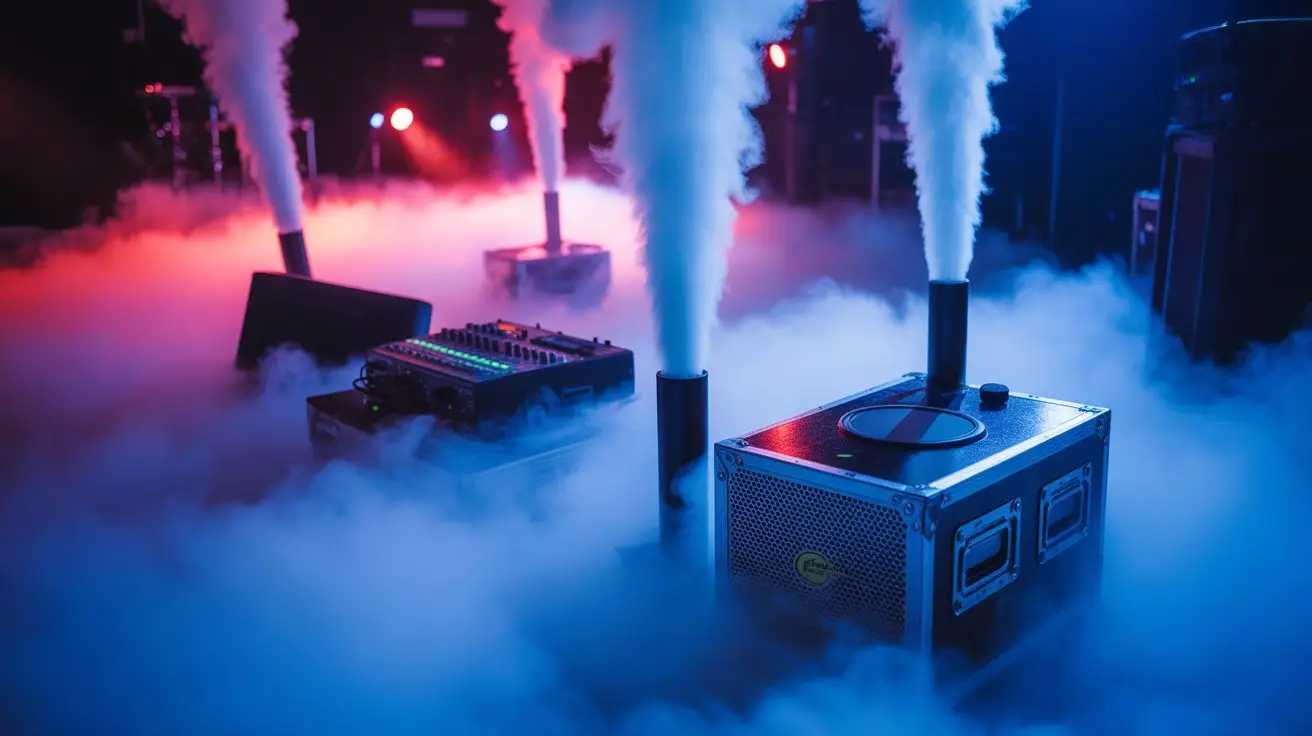
While consumer fog machines typically produce 1,000-3,000 CFM (cubic feet per minute) of output, professional-grade units generate 10,000-50,000 CFM with considerably denser particle concentrations. This substantial difference directly correlates to electronic damage risk levels.
Professional units maintain precise temperature controls and consistent particle size distribution, reducing condensation formation on sensitive components. Consumer models exhibit erratic output patterns and temperature fluctuations that increase moisture accumulation risks.
| Specification | Consumer Grade | Professional Grade |
|---|---|---|
| CFM Output | 1,000-3,000 | 10,000-50,000 |
| Particle Control | Variable | Precise |
| Electronic Risk | Moderate-High | Low-Moderate |
You’ll find professional fog machines incorporate built-in safety protocols, including automatic shutoff sensors and density regulation systems. Consumer units lack these protective features, making them more problematic for electronics-sensitive environments.
Alternative Atmospheric Effects for Sensitive Environments
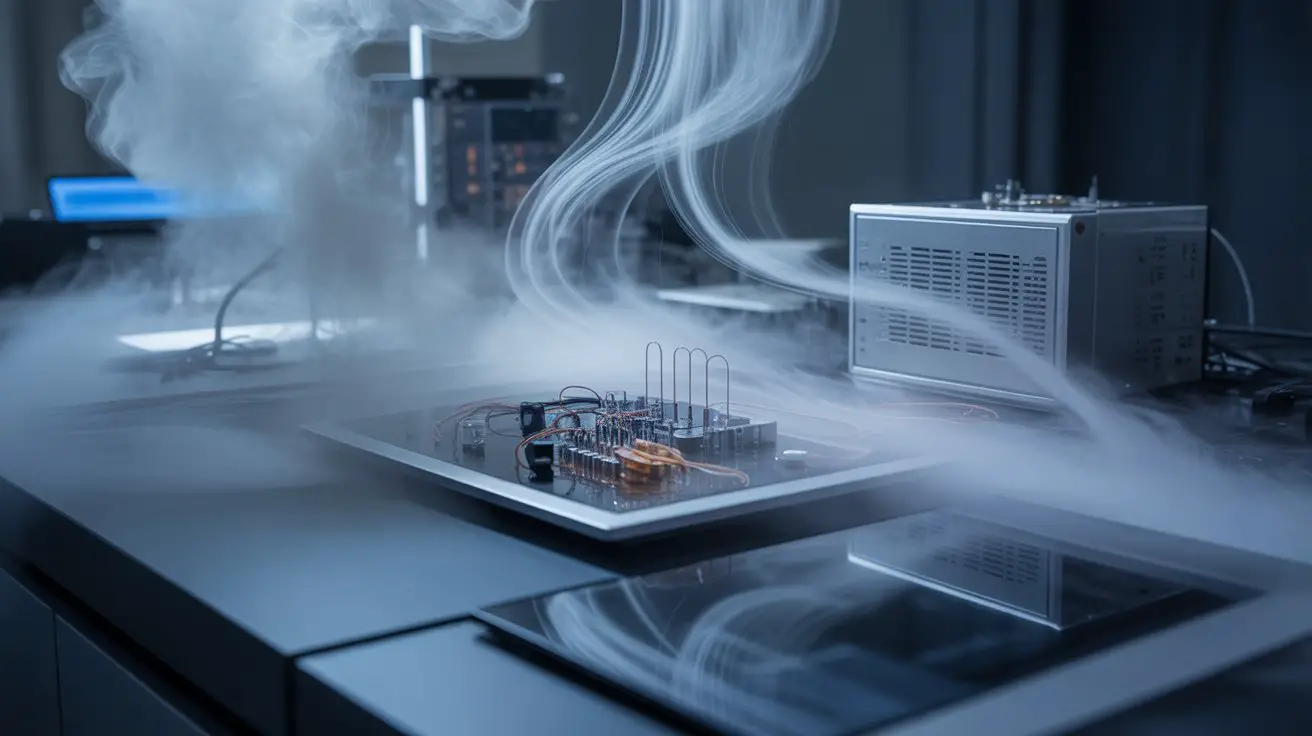
When electronics protection becomes paramount, you’ll need atmospheric effects that eliminate particle-based fog entirely. These alternatives provide visual impact without introducing moisture or residual particles that threaten sensitive equipment.
Consider these particle-free atmospheric solutions:
- LED wash lighting – Creates volumetric atmosphere through programmable color arrays without any emissions.
- Projection mapping – Generates smoke-like visual effects on surfaces using digital content overlay.
- Laser haze simulation – Produces beam patterns that mimic fog density through strategic light positioning.
- UV-reactive materials – Delivers atmospheric glow effects under blacklight without airborne particles.
- Dry ice sublimation chambers – Contains CO₂ effects within sealed systems, preventing electronic contact.
These methods maintain zero humidity increase and eliminate particulate contamination.
You’ll achieve dramatic atmospheric enhancement while preserving equipment integrity and operational reliability in mission-critical environments.
Frequently Asked Questions
How Long Should I Wait After Fogging Before Turning Electronics Back On?
You should wait thirty to sixty minutes after fogging before reactivating electronics. This timeframe allows fog particles to settle completely and residual moisture to evaporate, preventing condensation-related short circuits or component corrosion.
Can Fog Machines Trigger Smoke Detectors or Fire Alarm Systems?
Better safe than sorry—you’ll trigger photoelectric smoke detectors since fog particles scatter light beams. Ionization detectors react less reliably. Test your system’s sensitivity threshold beforehand and consider temporarily disabling detectors during fog operations.
Will Homeowner’s Insurance Cover Fog Machine Damage to My Electronics?
You’ll need to check your specific policy terms, as most standard homeowner’s insurance excludes intentional acts or negligent use of fog machines. Coverage depends on whether damage appears accidental versus deliberate recreational use.
Are There Specific Weather Conditions When Fog Machines Are Safer to Use?
You’ll find ideal conditions include low humidity below 50%, stable temperatures between 65-75°F, and minimal air circulation. These parameters reduce condensation risk and fluid particle settlement on sensitive components during operation.
Can I Clean Electronics Myself After Accidental Fog Machine Exposure?
You can clean electronics after fog exposure, but you’ll need proper techniques. Power down devices immediately, use isopropyl alcohol on circuit boards, and guarantee complete drying before reactivation to prevent permanent damage.
Conclusion
You’re walking a tightrope between spectacular effects and electronic catastrophe. The data’s crystal clear: fog machines release a perfect storm of moisture and glycol residues that’ll infiltrate your equipment’s circuits like water through a sieve. Your devices can’t withstand sustained humidity spikes beyond 60% RH—it’s electronic Russian roulette. Deploy strategic barriers, maintain calculated distances, and monitor environmental parameters religiously. One miscalculation transforms your gear into expensive paperweights.

